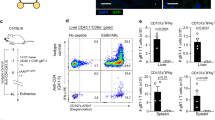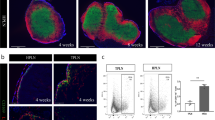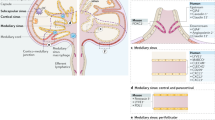Abstract
The lymphatic system is important in mounting an immune response to foreign antigens and tumors in humans and animal models. The liver produces a large amount of lymph, and its lymphatic system is divided into three major components: the portal, sublobular and superficial lymphatic vessels. Despite the fact that mice are the most commonly used laboratory animals, detailed descriptions of the anatomical location and function of the lymph nodes (LNs) that drain the liver are surprisingly absent. In this study, we found that the portal and celiac LNs adjacent to mouse liver were stained with Evans blue within 5–8 min. Enhanced green fluorescence protein (EGFP)-positive cells from the liver also drained into the two aforementioned LNs. These data indicate that the portal and celiac LNs drain the mouse liver. Lymphadenectomy of the identified liver-draining LNs resulted in hepatitis B virus (HBV) persistence in immunocompetent mice compared with the sham group. In addition, the frequencies of CD8+ T cells and dendritic cells (DCs) increased significantly in the liver-draining LNs after hydrodynamic injection of HBV plasmid. Liver-draining LN cells in HBV plasmid-injected mice also showed significant antigen-specific proliferation in response to stimulation with recombinant hepatitis B core antigen in vitro. Adoptive transfer of these cells into Rag1−/− mice induced a reduction in the serum concentration of hepatitis B surface antigen (HBsAg) compared to liver-draining LN cells in uninjected mice. Altogether our data characterize the liver-draining LNs and provide evidence that the liver-draining LNs induce an anti-HBV-specific immune response responsible for HBV clearance.
This is a preview of subscription content, access via your institution
Access options
Subscribe to this journal
Receive 12 digital issues and online access to articles
$119.00 per year
only $9.92 per issue
Buy this article
- Purchase on Springer Link
- Instant access to full article PDF
Prices may be subject to local taxes which are calculated during checkout






Similar content being viewed by others
References
Rehermann B, Nascimbeni M . Immunology of hepatitis B virus and hepatitis C virus infection. Nat Rev Immunol 2005; 5: 215–229.
Crispe IN . The liver as a lymphoid organ. Annu Rev Immunol 2009; 27: 147–163.
Racanelli V, Rehermann B . The liver as an immunological organ. Hepatology 2006; 43: S54–62.
Bertolino P, Bowen DG, McCaughan GW, Fazekas de St Groth B . Antigen-specific primary activation of CD8+ T cells within the liver. J Immunol 2001; 166: 5430–5438.
Ohtani O, Ohtani Y . Lymph circulation in the liver. Anat Rec (Hoboken) 2008; 291: 643–652.
Trutmann M, Sasse D . The lymphatics of the liver. Anat Embryol (Berl) 1994; 190: 201–209.
Ritchie HD, Grindlay JH, Bollman JL . Flow of lymph from the canine liver. Am J Physiol 1959; 196: 105–109.
Tang TJ, Vukosavljevic D, Janssen HL, Binda RS, Mancham S, Tilanus HW et al. Aberrant composition of the dendritic cell population in hepatic lymph nodes of patients with hepatocellular carcinoma. Hum Pathol 2006; 37: 332–338.
Tanis W, Mancham S, Binda R, Janssen HL, Bezemer G, IJzermans JN et al. Human hepatic lymph nodes contain normal numbers of mature myeloid dendritic cells but few plasmacytoid dendritic cells. Clin Immunol 2004; 110: 81–88.
Harrell MI, Iritani BM, Ruddell A . Lymph node mapping in the mouse. J Immunol Methods 2008; 332: 170–174.
Van den Broeck W, Derore A, Simoens P . Anatomy and nomenclature of murine lymph nodes: Descriptive study and nomenclatory standardization in BALB/cAnNCrl mice. J Immunol Methods 2006; 312: 12–19.
Matsuno K, Kudo S, Ezaki T, Miyakawa K . Isolation of dendritic cells in the rat liver lymph. Transplantation 1995; 60: 765–768.
Dong ZJ, Zhang JH, Sun R, Wei HM, Tian ZG . Impairment of liver regeneration correlates with activated hepatic NKT cells in HBV transgenic mice. Hepatology 2007; 45: 1400–1412.
Jiang Y, Li W, Yu L, Liu J, Xin G, Yan H et al. Enhancing the antihepatitis B virus immune response by adefovir dipivoxil and entecavir therapies. Cell Mol Immunol 2011; 8: 75–82.
Yang X, Gao X . Role of dendritic cells: a step forward for the hygiene hypothesis. Cell Mol Immunol 2011; 8: 12–18.
Wuensch SA, Pierce RH, Crispe IN . Local intrahepatic CD8+ T cell activation by a non-self-antigen results in full functional differentiation. J Immunol 2006; 177: 1689–1697.
Yoneyama H, Narumi S, Zhang Y, Murai M, Baggiolini M, Lanzavecchia A et al. Pivotal role of dendritic cell-derived CXCL10 in the retention of T helper cell 1 lymphocytes in secondary lymph nodes. J Exp Med 2002; 195: 1257–1266.
Derkow K, Loddenkemper C, Mintern J, Kruse N, Klugewitz K, Berg T et al. Differential priming of CD8 and CD4 T-cells in animal models of autoimmune hepatitis and cholangitis. Hepatology 2007; 46: 1155–1165.
Hultkrantz S, Ostman S, Telemo E . Induction of antigen-specific regulatory T cells in the liver-draining celiac lymph node following oral antigen administration. Immunology 2005; 116: 362–372.
Tilney NL . Patterns of lymphatic drainage in the adult laboratory rat. J Anat 1971; 109: 369–383.
Xu XD, Ueta H, Zhou S, Shi C, Koga D, Ushiki T et al. Trafficking of recirculating lymphocytes in the rat liver: rapid transmigration into the portal area and then to the hepatic lymph. Liver Int 2008; 28: 319–330.
Rashidi B, Gamagami R, Sasson A, Sun FX, Geller J, Moossa AR et al. An orthotopic mouse model of remetastasis of human colon cancer liver metastasis. Clin Cancer Res 2000; 6: 2556–2561.
Huang LR, Wu HL, Chen PJ, Chen DS . An immunocompetent mouse model for the tolerance of human chronic hepatitis B virus infection. Proc Natl Acad Sci U S A 2006; 103: 17862–17867.
Lang PA, Recher M, Honke N, Scheu S, Borkens S, Gailus N et al. Tissue macrophages suppress viral replication and prevent severe immunopathology in an interferon-I-dependent manner in mice. Hepatology 2010; 52: 25–32.
Li CZ, Liang ZK, Chen ZR, Lou HB, Zhou Y, Zhang ZH et al. Identification of HBsAg-specific antibodies from a mammalian cell displayed full-length human antibody library of healthy immunized donor. Cell Mol Immunol 2012; 9: 184–190.
Zheng M, Tian Z . The trafficking of hepatic NK cells to liver draining lymph nodes. Hepatol Int 2010; 4: 333.
Barbier L, Tay SS, McGuffog C, Triccas JA, McCaughan GW, Bowen DG et al. Two lymph nodes draining the mouse liver are the preferential site of DC migration and T cell activation. J Hepatol 2012; 57: 352–358.
Acknowledgements
This work was supported by the Ministry of Science and Technology of China (973 Basic Science Project 2013CB944902), the Natural Science Foundation of China (Nos. 91029303, 31021061) and the National Science and Technology Major Projects (2013ZX10002002-002). We thank Professor Pei-Jer Chen for providing the pAAV-HBV plasmid.
Author information
Authors and Affiliations
Corresponding author
Rights and permissions
About this article
Cite this article
Zheng, M., Yu, J. & Tian, Z. Characterization of the liver-draining lymph nodes in mice and their role in mounting regional immunity to HBV. Cell Mol Immunol 10, 143–150 (2013). https://doi.org/10.1038/cmi.2012.59
Received:
Revised:
Accepted:
Published:
Issue Date:
DOI: https://doi.org/10.1038/cmi.2012.59
Keywords
This article is cited by
-
Evaluating the ameliorative effect of nano bis-demethoxy curcumin analog against extrapulmonary toxicity in rat induced by inhaled multi-walled carbon nanotube
Environmental Science and Pollution Research (2023)
-
Liver metastasis restrains immunotherapy efficacy via macrophage-mediated T cell elimination
Nature Medicine (2021)
-
Natural killer cells in liver diseases
Frontiers of Medicine (2018)
-
Dynamics of antigen presentation to transgene product-specific CD4+ T cells and of Treg induction upon hepatic AAV gene transfer
Molecular Therapy - Methods & Clinical Development (2016)



